An Examination of the Evolution of Green Industry Structure and Sustainable Cooperation Strategies Between China and the Visegrád Group: A Product Space Approach
Abstract
1. Introduction
2. Theoretical Basis and Literature Review
2.1. Product Space Theory
2.2. Research on the Green Product Space
2.3. Research on International Cooperation and Green Development Between China and V4 Countries
3. Data Sources and Research Methods
3.1. Data Sources
3.2. Methods
3.2.1. Comparative Advantage Matrix
3.2.2. Product Space Network
3.2.3. Green Complexity Index
3.2.4. Green Development Potential
- (1)
- Green product density (GDE)
- (2)
- Green Complexity Potential (GCP)
3.2.5. Green Competitiveness Index
4. Results
4.1. Green Products Trade Between China and the V4 Countries
4.2. Green Product Complexity (PCI) and National Green Complexity GCI
4.3. Spatial Distribution and Structural Differences of the Green Product Spatial Network in China and V4 Countries
5. Discussion
5.1. GCPs of China and V4 Countries
5.2. Similarities in Green Exports and Potential Between China and V4 Countries
6. Conclusions and Implications
6.1. Conclusions
6.2. Insights on Sustainable Cooperation Strategies
6.3. Limitations and Future Directions
Author Contributions
Funding
Data Availability Statement
Conflicts of Interest
Abbreviations
| CEEC | Central and Eastern Europe |
| CBAM | Carbon Border Adjustment Mechanism |
| V4 | Visegrád Group |
| GCI | Green Complexity Index |
| ECI | Economic Complexity Index |
| GDE | Green product density |
| SGP | Similarity Green Product |
| SGPD | Similarity Green Product Development |
| SDGs | sustainable development goals |
| BRI | The Belt and Road Initiative |
Appendix A
| OECD Environmental Classification | Green (Environmental) Product List | |
|---|---|---|
| A. Pollution management | A1. Air pollution control | 252100, 252220, 281610, 701990, 840510, 841410, 841430, 841440, 841480, 841490, 841780, 841960, 841989, 842139, 842199, 842490, 851410, 851420, 851430, 851490 |
| A2. Wastewater management | 280110, 281410, 281511, 281512, 281830, 282010, 282410, 283210, 283220, 283510, 283522, 283523, 283524, 283525, 283526, 283529, 380210, 392690, 460120, 580190, 730900, 731010, 731021, 731029, 732490, 732510, 840420, 841011, 841012, 841013, 841090, 841320, 841350, 841360, 841370, 841381, 841939, 842119, 842121, 842129, 842191, 842381, 842382, 842389, 848110, 848130, 848140, 848180, 902610, 902620 | |
| A3. Solid waste management | 392020, 392490, 681099, 780600, 841790, 842220, 847420, 847439, 847982, 847989, 847990, 851629, 901320, 960310, 960350, 960390 | |
| A4. Remediation and cleanup | 854389, 854390 | |
| A5. Noise and vibration reduction | 840991, 840999, 870892 | |
| A6. Environmental monitoring, analysis, and assessment | 901580, 902511, 902519, 902580, 902680, 902690, 902710, 902720, 902730, 902740, 902750, 902780, 902790, 903010, 903149, 903180, 903190, 903210, 903220, 903281, 903289, 903290, 903300 | |
| B. Clean technologies and products | B1. Clean/resource-saving technologies and processes | 732111, 840290, 840410, 840490, 850410 |
| B2. Cleaner/resource-saving products | 320910, 320990 | |
| C. Resource management | C2. Water supply | 220190, 285100, 391400 |
| C4. Renewable energy equipment | 220710, 290511, 730820, 840681, 840690, 841181, 841182, 841199, 841290, 841861, 841911, 841919, 850164, 850231, 850239, 850300, 850490, 853710, 854140, 900190, 900290, 901380, 901390 | |
| C5. Thermal energy/energy conservation and management | 381511, 381512, 381519, 700800, 841950, 841990, 853931, 902810, 902820 | |
Appendix B
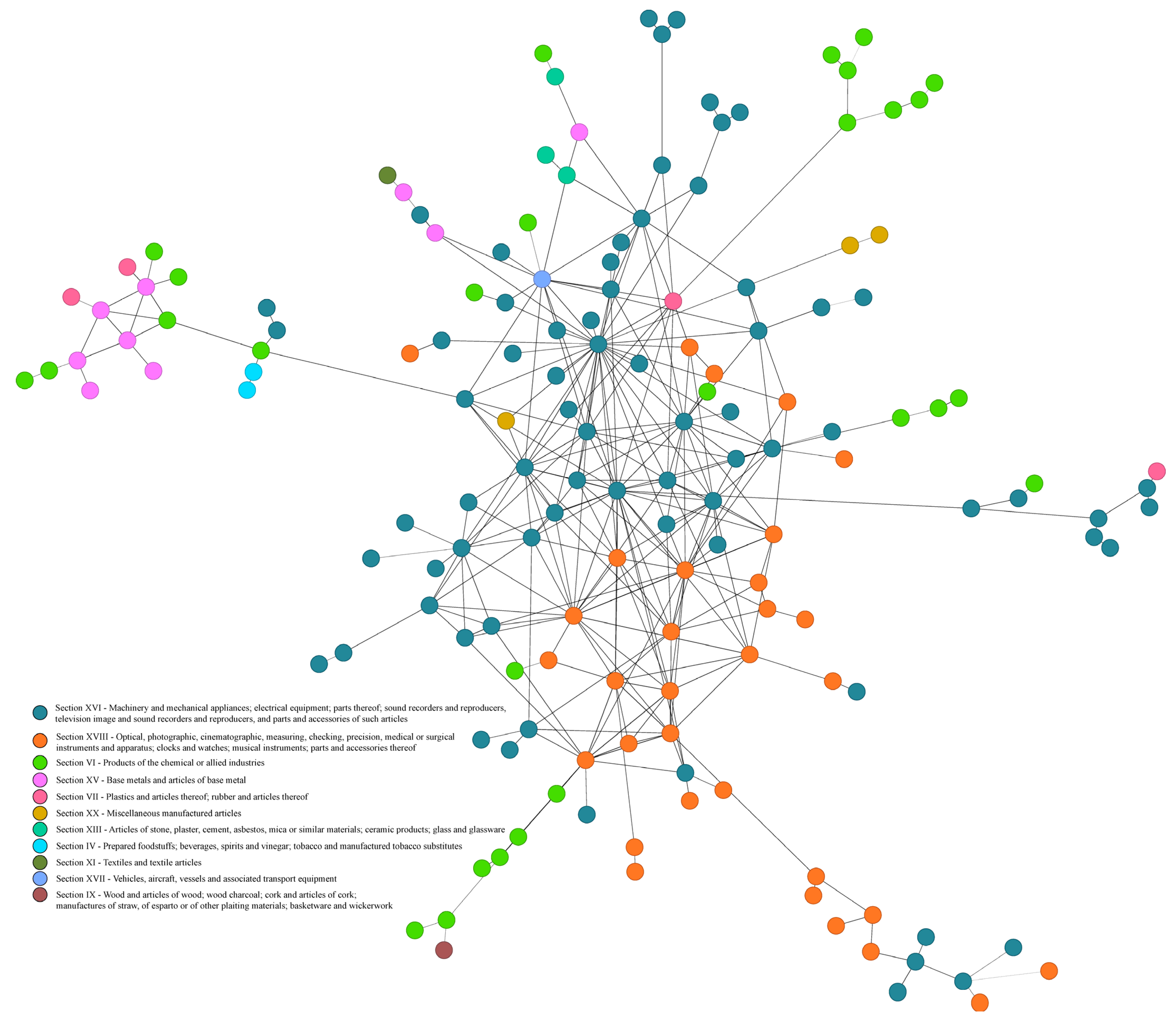
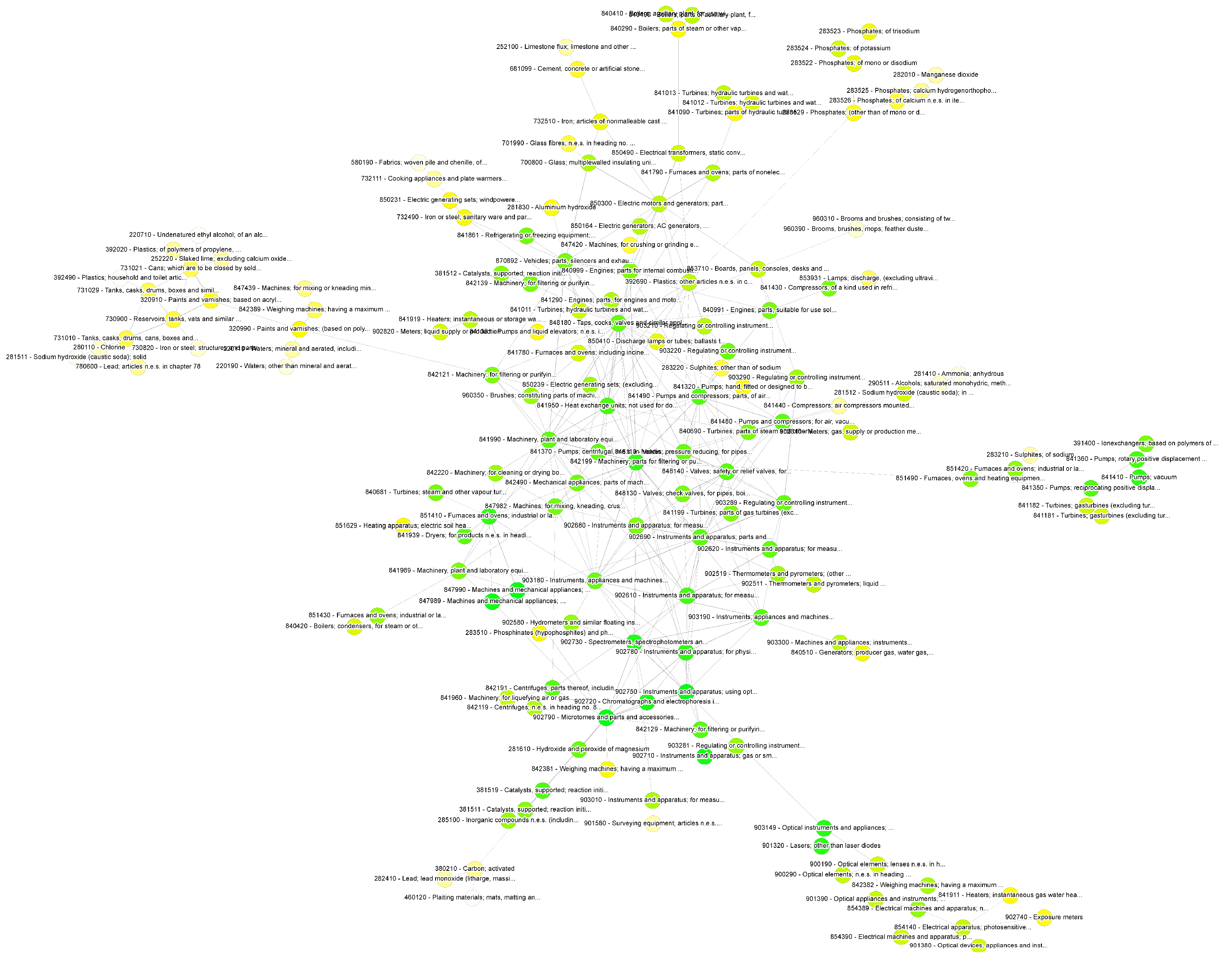
References
- Evro, S.; Oni, B.A.; Tomomewo, O.S. Global strategies for a low-carbon future: Lessons from the US, China, and EU’s pursuit of carbon neutrality. J. Clean. Prod. 2024, 461, 142635. [Google Scholar] [CrossRef]
- Zheng, X.; Sun, A. Digital Services Trade between China and V4 Countries—A Study of Trade Complementarity and Regulatory Restrictiveness. Ekon. Cas. 2023, 71, 139–154. [Google Scholar] [CrossRef]
- Hidalgo, C.A. Economic complexity theory and applications. Nat. Rev. Phys. 2021, 3, 92–113. [Google Scholar] [CrossRef]
- Coniglio, N.D.; Lagravinese, R.; Vurchio, D.; Armenise, M. The pattern of structural change: Testing the product space framework. Ind. Corp. Change 2018, 27, 763–785. [Google Scholar] [CrossRef]
- Romero, J.P.; Gramkow, C. Economic complexity and greenhouse gas emissions. World Devel. 2021, 139, 105317. [Google Scholar] [CrossRef]
- Hausmann, R.; Klinger, B. The Evolution of Comparative Advantage: The Impact of the Structure of the Product Space; Center for International Development and Kennedy School of Government, Harvard University: Cambridge, MA, USA, 2006. [Google Scholar]
- Coniglio, N.D.; Vurchio, D.; Cantore, N.; Clara, M. On the evolution of comparative advantage: Path-dependent versus path-defying changes. J. Int. Econ. 2021, 133, 103522. [Google Scholar] [CrossRef]
- Mealy, P.; Teytelboym, A. Economic complexity and the green economy. Res. Pol. 2022, 51, 103948. [Google Scholar] [CrossRef]
- Fraccascia, L.; Giannoccaro, I.; Albino, V. Green product development: What does the country product space imply? J. Clean. Prod. 2018, 170, 1076–1088. [Google Scholar] [CrossRef]
- Luo, J.; Dong, J.; Tan, Z.; Zhang, H.; Zhang, W. Relatedness, digital economy and renewable energy product evolution—Based on product space perspective. Energy Policy 2024, 186, 113991. [Google Scholar] [CrossRef]
- Qi, X.; Xiao, W.; Xiang, X. The spatial pattern of the blue product development of nations: An empirical analysis based on product space theory. Ocean. Coast. Manag. 2021, 207, 105596. [Google Scholar] [CrossRef]
- Gazheli, A.; Van Den Bergh, J.; Antal, M. How realistic is green growth? Sectoral-level carbon intensity versus productivity. J. Clean. Prod. 2016, 129, 449–467. [Google Scholar] [CrossRef]
- Boschma, R.; Heimeriks, G.; Balland, P.-A. Scientific knowledge dynamics and relatedness in biotech cities. Res. Pol. 2014, 43, 107–114. [Google Scholar] [CrossRef]
- Hu, F.; Qiu, L.; Zhou, H. Medical Device Product Innovation Choices in Asia: An Empirical Analysis Based on Product Space. Front. Public Health 2022, 10, 871575. [Google Scholar] [CrossRef] [PubMed]
- Huberty, M.; Zachmann, G. Green Exports and the Global Product Space: Prospects for EU Industrial Policy; 2011/07; Bruegel: Brussels, Belgium, 2011. [Google Scholar]
- Balland, P.-A.; Broekel, T.; Diodato, D.; Giuliani, E.; Hausmann, R.; O’Clery, N.; Rigby, D. The new paradigm of economic complexity. Res. Pol. 2022, 51, 104450. [Google Scholar] [CrossRef]
- Doğan, B.; Saboori, B.; Can, M. Does economic complexity matter for environmental degradation? An empirical analysis for different stages of development. Environ. Sci. Pollut. Res. 2019, 26, 31900–31912. [Google Scholar] [CrossRef]
- Mai, N.T.; Hoa, T.T.M.; Huyen, N.T.T. Effects of digitalization on natural resource use in European countries: Does economic complexity matter? Int. J. Energy Econ. Policy 2022, 12, 77–92. [Google Scholar] [CrossRef]
- Qiu, L.; Xia, W.; Wei, S.; Hu, H.; Yang, L.; Chen, Y.; Zhou, H.; Hu, F. Collaborative management of environmental pollution and carbon emissions drives local green growth: An analysis based on spatial effects. Environ. Res. 2024, 259, 119546. [Google Scholar] [CrossRef]
- Song, W. China’s Relations with Central and Eastern Europe; Routledge: Abingdon, UK, 2017. [Google Scholar]
- Kavalski, E. China in Central and Eastern Europe: The unintended effects of identity narratives. Asia Eur. J. 2019, 17, 403–419. [Google Scholar] [CrossRef]
- Stanojevic, S.; Qiu, B.; Chen, J. A Study on Trade between China and Central and Eastern European Countries: Does the 16+1 Cooperation Lead to Significant Trade Creation? East. Europ. Econ. 2021, 59, 1–22. [Google Scholar] [CrossRef]
- Nikolić, G. Changes in the structure of trade between China and the countries of central and eastern Europe in the period after the initiation of format 17+1. Argum. Oeconomica 2021, 2021, 39–61. [Google Scholar] [CrossRef]
- Matura, T. Chinese investment in the EU and Central and Eastern Europe. In China’s Attraction: The Case of Central Europe; Budapest Business School, University of Applied Sciences: Budapest, Hungary, 2017; pp. 49–71. [Google Scholar]
- Zheng, Z.; Song, Z.; Ji, Q.; Xiong, W. Spatiotemporal evolution of production cooperation between China and Central and Eastern European countries: An analysis based on the input–output technique. Growth Change 2021, 52, 1117–1136. [Google Scholar] [CrossRef]
- Sulich, A.; Sołoducho-Pelc, L. Renewable Energy Producers’ Strategies in the Visegrád Group Countries. Energies 2021, 14, 3048. [Google Scholar] [CrossRef]
- Riepl, T.; Zavarská, Z. Towards a Greener Visegrád Group: Progress and Challenges in the Context of the European Green Deal; The Vienna Institute for International Economic Studies: Vienna, Austria, 2023. [Google Scholar]
- Jaworski, S.; Chrzanowska, M.; Zielińska-Sitkiewicz, M.; Pietrzykowski, R.; Jezierska-Thöle, A.; Zielonka, P. Evaluating the Progress of Renewable Energy Sources in Poland: A Multidimensional Analysis. Energies 2023, 16, 6431. [Google Scholar] [CrossRef]
- Durcansky, P.; Zvada, B.; Nosek, R.; Najser, J.; Najser, T. Evolution of Green Energy Production in Czech Republic. Appl. Sci. 2023, 13, 2185. [Google Scholar] [CrossRef]
- Kumar, B.; Szepesi, G.; Čonka, Z.; Kolcun, M.; Péter, Z.; Berényi, L.; Szamosi, Z. Trendline assessment of solar energy potential in hungary and current scenario of renewable energy in the visegrád countries for future sustainability. Sustainability 2021, 13, 5462. [Google Scholar] [CrossRef]
- Piwowar, A.; Dzikuć, M.; Dzikuć, M. The potential of wind energy development in Poland in the context of legal and economic changes. Acta Polytech. Hung. 2023, 20, 145–156. [Google Scholar] [CrossRef]
- Šafařík, D.; Hlaváčková, P.; Michal, J. Potential of forest biomass resources for renewable energy production in the Czech Republic. Energies 2021, 15, 47. [Google Scholar] [CrossRef]
- Knápek, J.; Vávrová, K.; Králík, T.; Outrata, D. Biomass potential—Theory and practice: Case example of the Czech Republic region. Energy Rep. 2020, 6, 292–297. [Google Scholar] [CrossRef]
- Szűcs, P.; Turai, E.; Mádai, V.; Vass, P.; Miklós, R.; Zákányi, B.; Ilyés, C.; Fekete, Z.; Kilik, R.; Móricz, F. Innovation in assessment of the geothermal energy potential of abandoned hydrocarbon wells in the southern and southeastern foreground of the Bükk Mountains, northeast Hungary. Hydrogeol. J. 2022, 30, 2267–2284. [Google Scholar] [CrossRef]
- Atikur Rahaman, M.; Bin Amin, M.; Taru, R.D.; Ahammed, M.R.; Rabbi, M.F. An analysis of renewable energy consumption in Visegrád countries. Environ. Res. Commun. 2023, 5, 105013. [Google Scholar] [CrossRef]
- Kochanek, E. The energy transition in the Visegrad group countries. Energies 2021, 14, 2212. [Google Scholar] [CrossRef]
- Brożyna, J.; Strielkowski, W.; Zpěvák, A. Evaluating the chances of implementing the “Fit for 55” Green Transition Package in the V4 countries. Energies 2023, 16, 2764. [Google Scholar] [CrossRef]
- Antal, M. How the regime hampered a transition to renewable electricity in Hungary. Environ. Innov. Soc. Transit. 2019, 33, 162–182. [Google Scholar] [CrossRef]
- Kiselakova, D.; Stec, M.; Grzebyk, M.; Sofrankova, B. A multidimensional evaluation of the sustainable development of European Union countries—An empirical study. J. Compet. 2020, 12, 56–73. [Google Scholar] [CrossRef]
- Domaracká, L.; Seňová, A.; Kowal, D. Evaluation of Eco-Innovation and Green Economy in EU Countries. Energies 2023, 16, 962. [Google Scholar] [CrossRef]
- Kułyk, P.; Kaźmierczak-Piwko, L.; Gąsiorek-Kowalewicz, A.; Świstak, P. Development of green jobs in the res sector in the Visegrad Group countries. Multidiscip. Asp. Prod. Eng. 2019, 2, 570–588. [Google Scholar] [CrossRef][Green Version]
- Lall, S. The Technological Structure and Performance of Developing Country Manufactured Exports, 1985-98. Oxf. Devel. Stud. 2000, 28, 337–369. [Google Scholar] [CrossRef]
- Kulhanek, L.; Sulich, A.; Zema, T. European integration and real convergence in V4 Group: Transformation towards green economy. In Proceedings of the 6th International Conference on European Integration, Ostrava, Czech Republic, 19–20 May 2022; pp. 363–371. [Google Scholar]
- Misztal, A.; Kowalska, M. Factors of green entrepreneurship in selected emerging markets in the European Union. Environ. Dev. Sustain. 2023, 26, 28269–28292. [Google Scholar] [CrossRef]
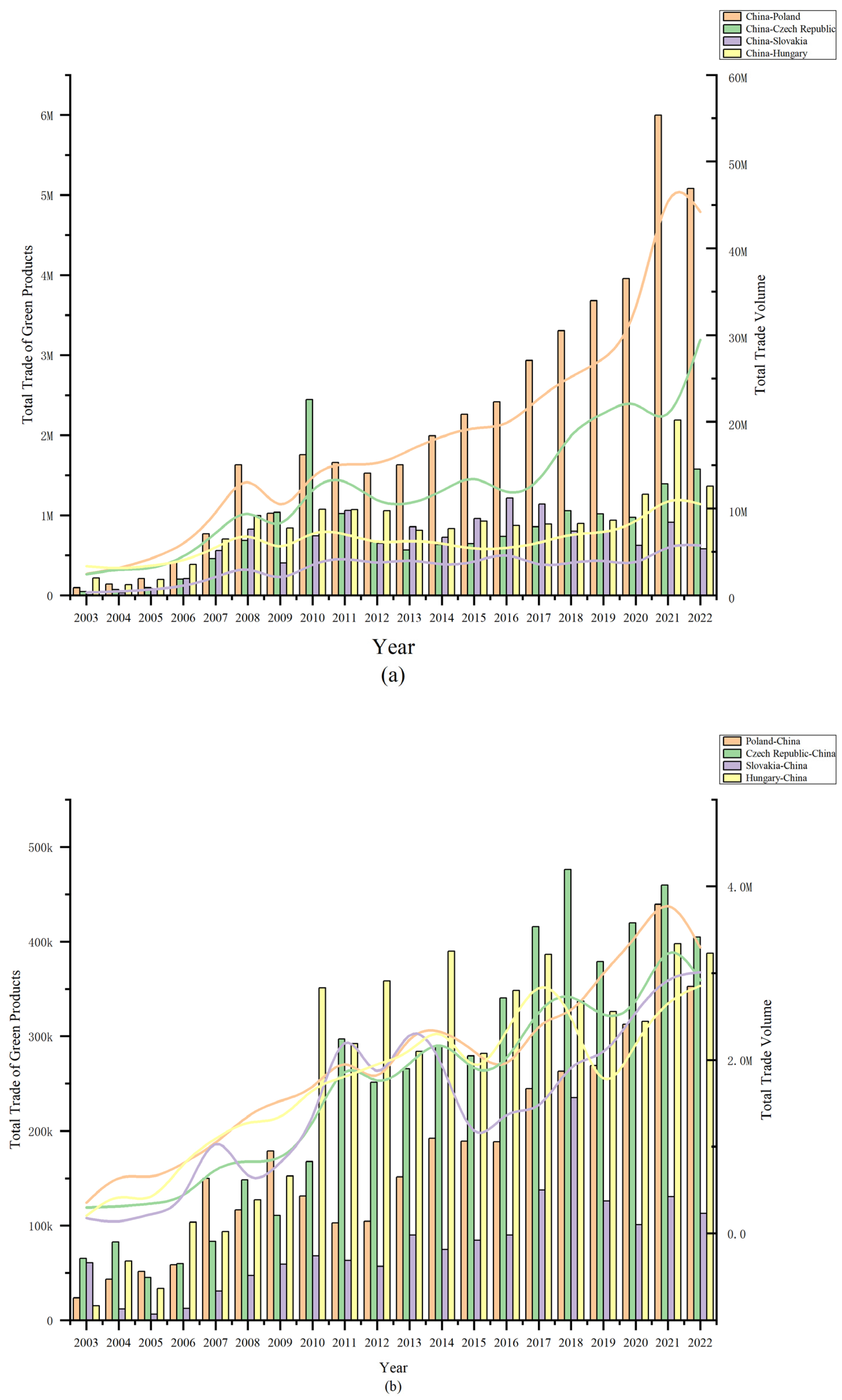
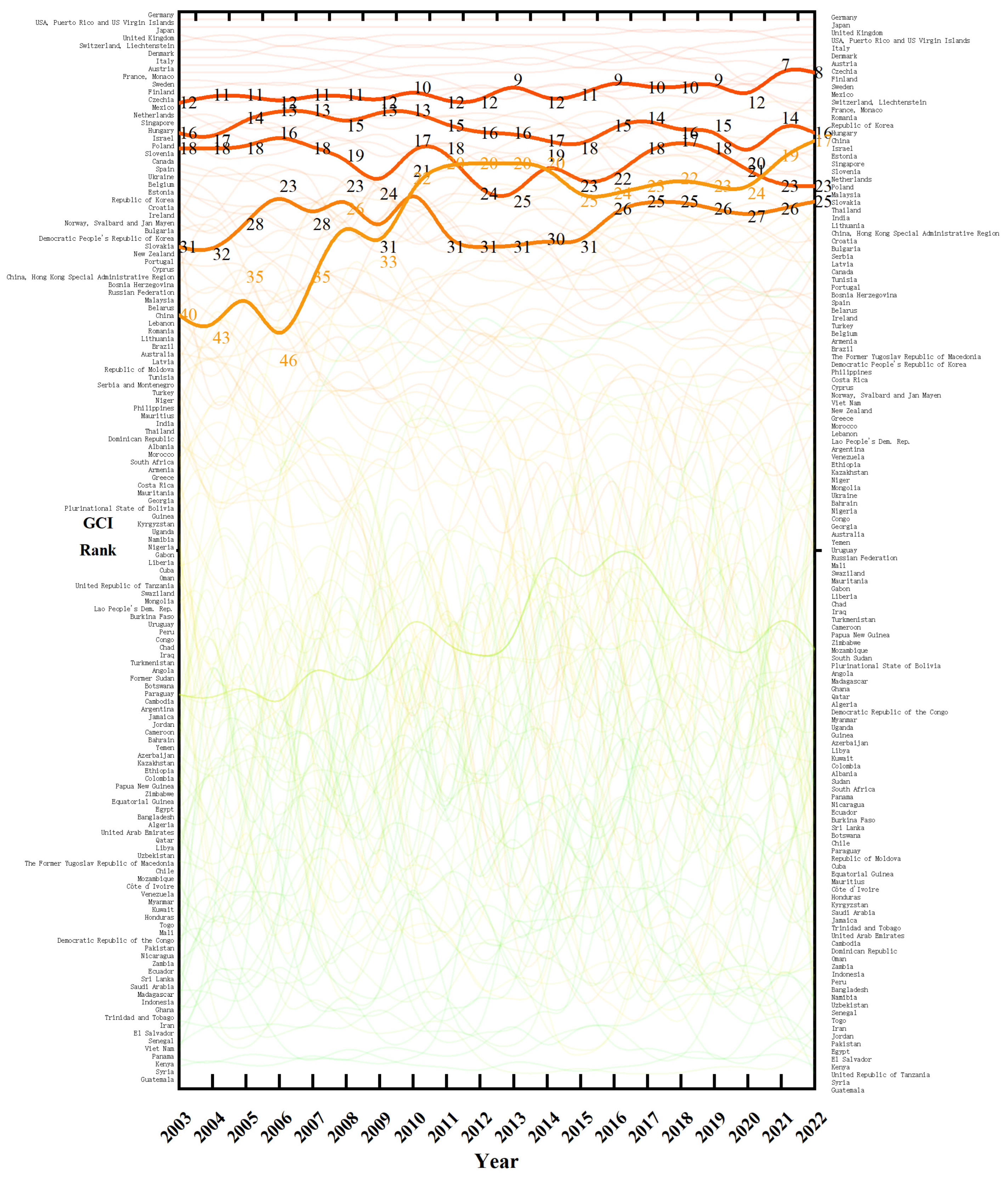
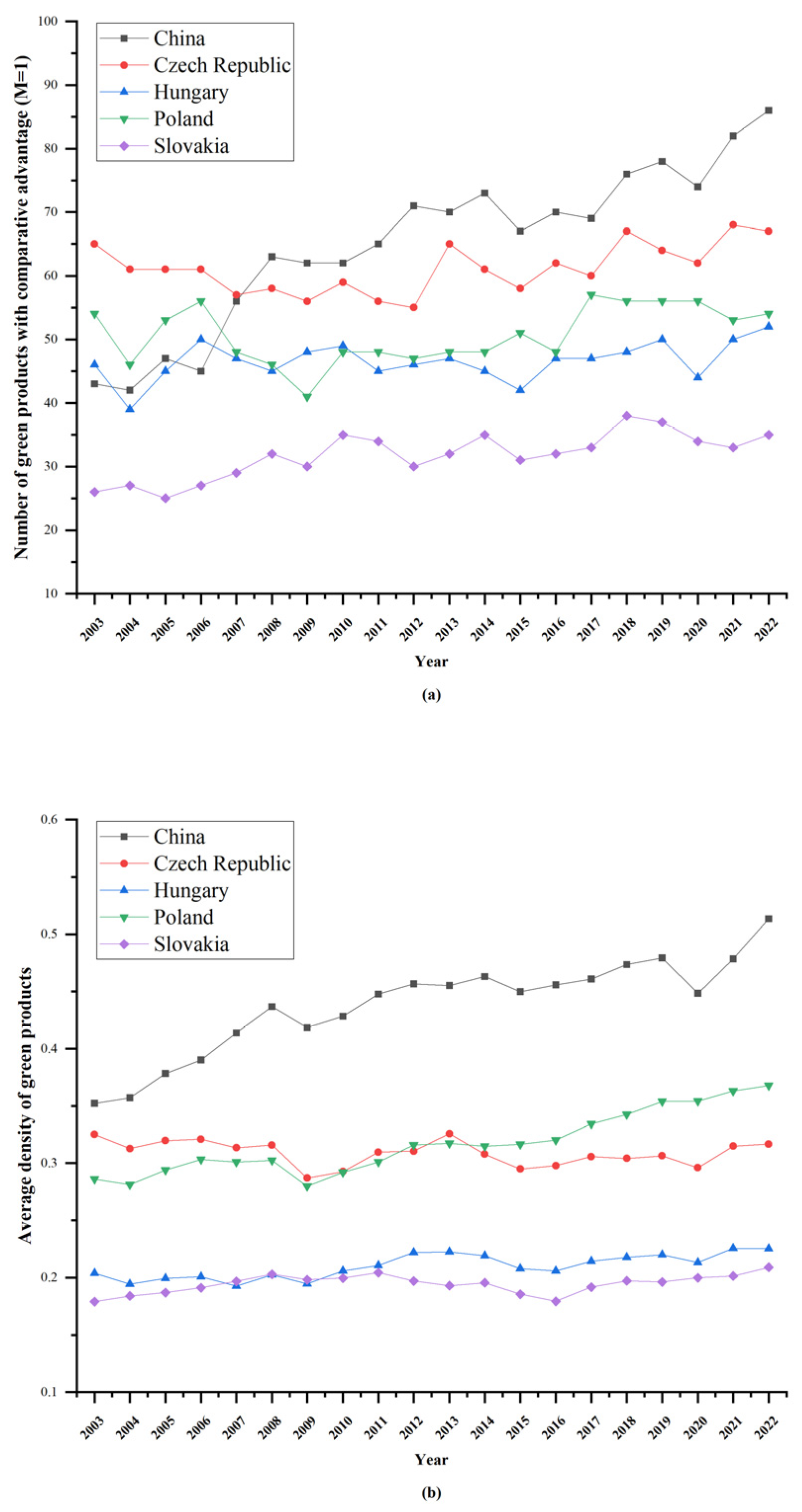

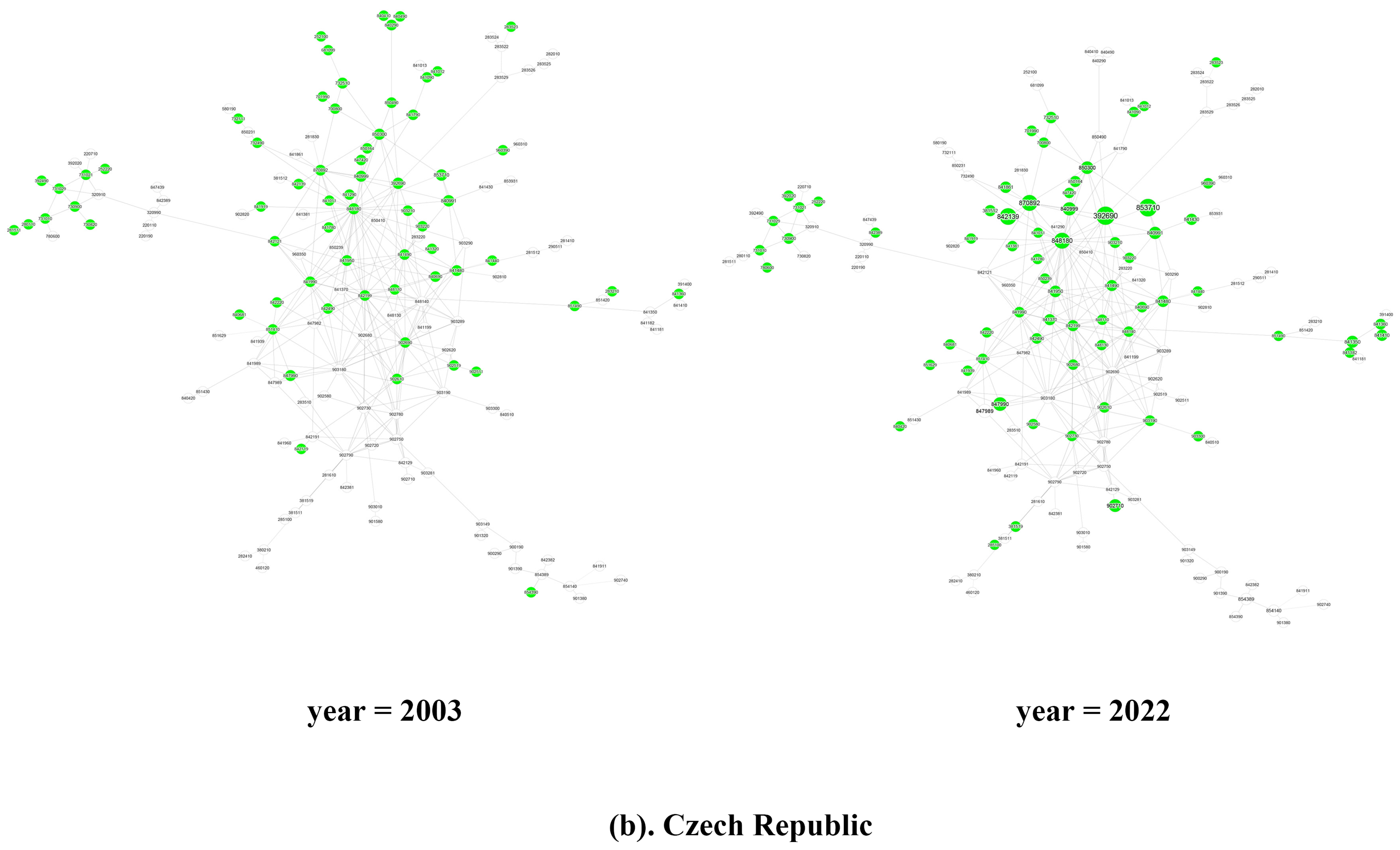
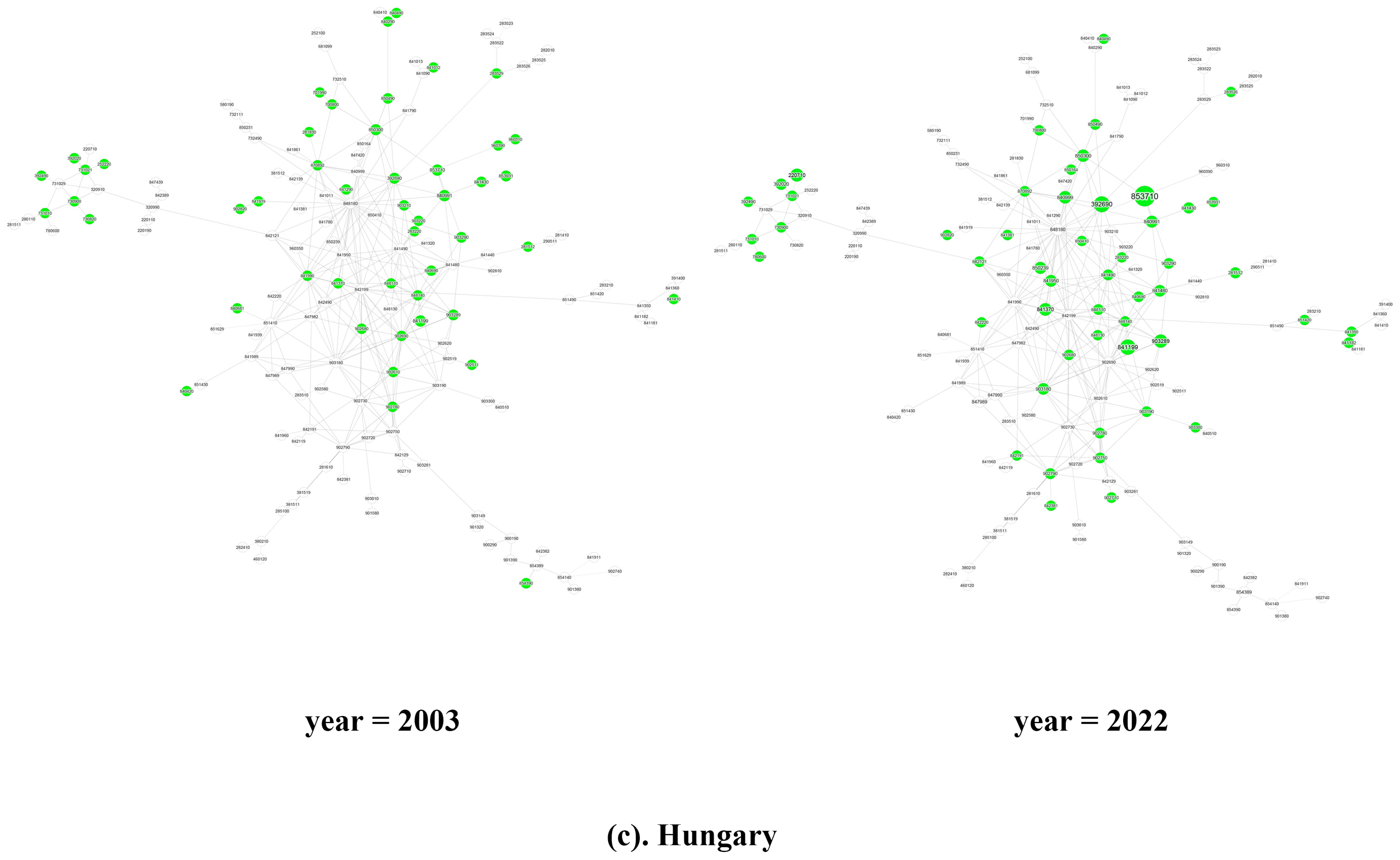
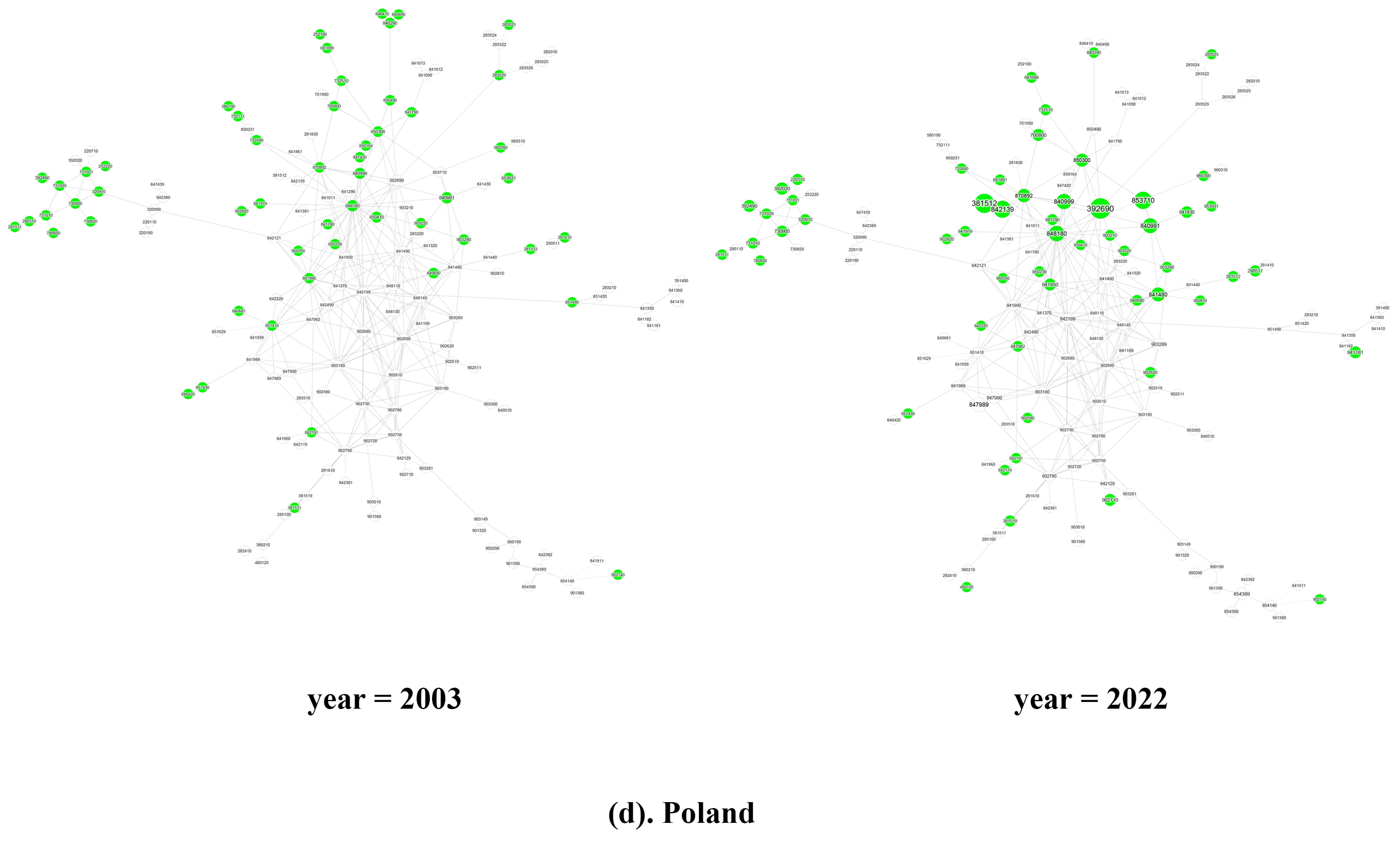
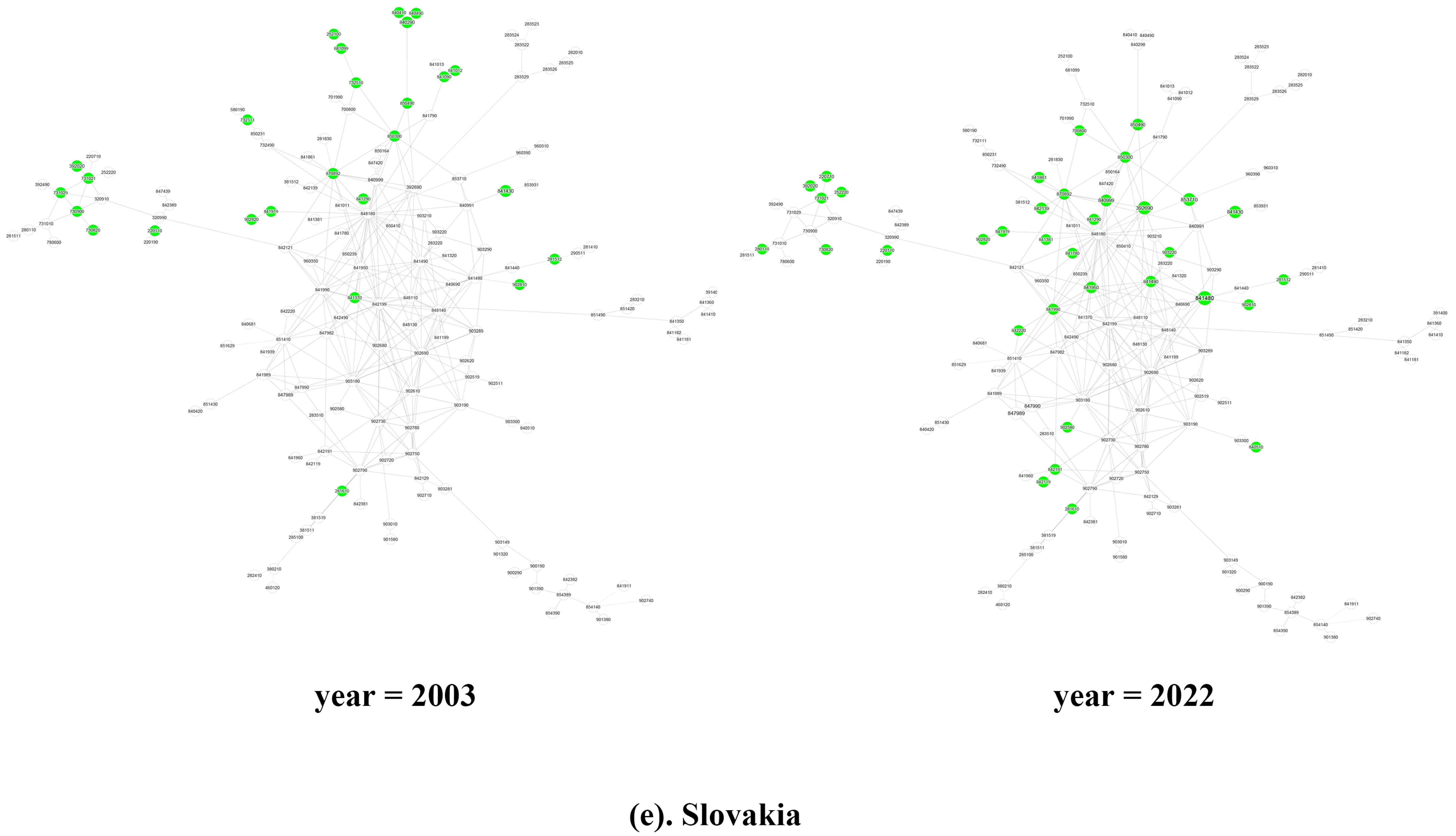

| Top 10 Green Products by Average Complexity | Bottom 10 Green Products by Average Complexity | ||||||
|---|---|---|---|---|---|---|---|
| HS96 | Product description | Mean PCI | Environmental classification | HS96 | Product description | Mean PCI | Environmental classification |
| 902750 | Other instruments and devices using optical radiation | 1.736 | A6. Environmental monitoring, analysis, and assessment | 460120 | Woven materials such as cushions, mats, and partitions | −1.898 | A2. Wastewater management |
| 902790 | Parts of microtome and physical and chemical analysis instruments | 1.719 | A6. Environmental monitoring, analysis, and assessment | 960310 | Brooms made of twigs or other plant materials | −1.600 | A3. Solid waste management |
| 847990 | Other parts of machines listed under catalog 84.79 | 1.714 | A3. Solid waste management | 392490 | Other plastic household ware and sanitary or toilet articles | −1.225 | A3. Solid waste management |
| 847989 | Other machines and mechanical apparatus not listed in this study | 1.656 | A3. Solid waste management | 220710 | Undenatured ethanol with an alcohol content of over 80% | −1.124 | C4. Renewable energy equipment |
| 902710 | Gas or smoke analyzers | 1.649 | A6. Environmental monitoring, analysis, and assessment | 281511 | Solid caustic soda | −0.833 | A2. Wastewater management |
| 902720 | Chromatographs, etc. | 1.622 | A6. Environmental monitoring, analysis, and assessment | 281410 | Anhydrous ammonia | −0.751 | A2. Wastewater management |
| 902730 | Spectrometers, etc. | 1.572 | A6. Environmental monitoring, analysis and assessment | 580190 | Linen and ramie pile woven fabrics and chenille fabrics | −0.738 | A2. Wastewater management |
| 903149 | Other optical measuring or testing instruments and apparatus | 1.546 | A6. Environmental monitoring, analysis, and assessment | 220190 | Other natural water | −0.691 | C2. Water supply |
| 901320 | Other lasers | 1.515 | A3. Solid waste management | 960390 | Brooms, brushes, mops, and dusters | −0.649 | A3. Solid waste management |
| 841410 | Vacuum pumps | 1.509 | A1. Air pollution control | 730820 | Steel towers and lattice masts | −0.626 | C4. Renewable energy equipment |
| 2003 | 2008 | 2013 | 2018 | 2022 | ||||||
|---|---|---|---|---|---|---|---|---|---|---|
| Country | GCP | Global Ranking | GCP | Global Ranking | GCP | Global Ranking | GCP | Global Ranking | GCP | Global Ranking |
| China | 3.168 | 1 | 4.164 | 1 | 4.265 | 1 | 4.694 | 1 | 4.667 | 1 |
| Czech Republic | 2.079 | 8 | 1.355 | 12 | 1.586 | 11 | 1.236 | 14 | 1.133 | 15 |
| Hungary | 0.942 | 20 | 0.683 | 31 | 0.886 | 24 | 0.939 | 23 | 0.711 | 28 |
| Poland | 1.943 | 9 | 1.815 | 9 | 2.096 | 7 | 2.125 | 6 | 2.415 | 6 |
| Slovakia | 0.836 | 28 | 0.876 | 25 | 0.844 | 26 | 0.970 | 21 | 0.878 | 21 |
| 2022-SGP | China | Czech Republic | Hungary | Poland | Slovakia | 2022-SGPD | China | Czech Republic | Hungary | Poland | Slovakia |
|---|---|---|---|---|---|---|---|---|---|---|---|
| China | 1.000 | China | 1.000 | ||||||||
| Czech Republic | 0.407 | 1.000 | Czech Republic | 0.163 | 1.000 | ||||||
| Hungary | 0.256 | 0.463 | 1.000 | Hungary | 0.186 | 0.156 | 1.000 | ||||
| Poland | 0.326 | 0.463 | 0.500 | 1.000 | Poland | 0.205 | 0.364 | 0.136 | 1.000 | ||
| Slovakia | 0.174 | 0.328 | 0.365 | 0.444 | 1.000 | Slovakia | 0.186 | 0.313 | 0.194 | 0.273 | 1.000 |
Disclaimer/Publisher’s Note: The statements, opinions and data contained in all publications are solely those of the individual author(s) and contributor(s) and not of MDPI and/or the editor(s). MDPI and/or the editor(s) disclaim responsibility for any injury to people or property resulting from any ideas, methods, instructions or products referred to in the content. |
© 2025 by the authors. Licensee MDPI, Basel, Switzerland. This article is an open access article distributed under the terms and conditions of the Creative Commons Attribution (CC BY) license (https://creativecommons.org/licenses/by/4.0/).
Share and Cite
Qiu, L.; Chen, Q.; Zhu, X.; Yang, L.; Gu, W. An Examination of the Evolution of Green Industry Structure and Sustainable Cooperation Strategies Between China and the Visegrád Group: A Product Space Approach. Systems 2025, 13, 508. https://doi.org/10.3390/systems13070508
Qiu L, Chen Q, Zhu X, Yang L, Gu W. An Examination of the Evolution of Green Industry Structure and Sustainable Cooperation Strategies Between China and the Visegrád Group: A Product Space Approach. Systems. 2025; 13(7):508. https://doi.org/10.3390/systems13070508
Chicago/Turabian StyleQiu, Liping, Qianxue Chen, Xinzhe Zhu, Lihua Yang, and Wenbo Gu. 2025. "An Examination of the Evolution of Green Industry Structure and Sustainable Cooperation Strategies Between China and the Visegrád Group: A Product Space Approach" Systems 13, no. 7: 508. https://doi.org/10.3390/systems13070508
APA StyleQiu, L., Chen, Q., Zhu, X., Yang, L., & Gu, W. (2025). An Examination of the Evolution of Green Industry Structure and Sustainable Cooperation Strategies Between China and the Visegrád Group: A Product Space Approach. Systems, 13(7), 508. https://doi.org/10.3390/systems13070508






